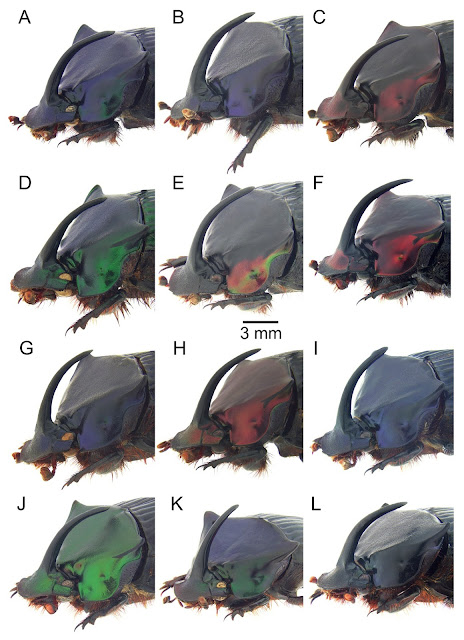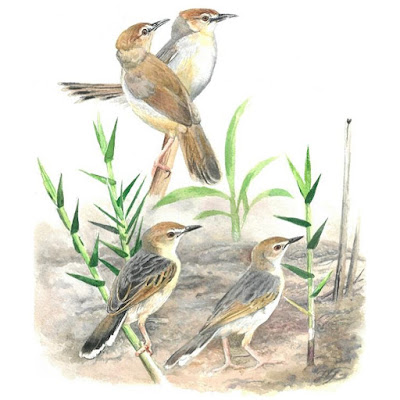[Most Recent Entries] [Calendar View]
Friday, June 11th, 2021
| Time | Event | ||
| 4:13a | [Entomology • 2021] Taxonomic Revision of the Phanaeus endymion species Group (Coleoptera: Scarabaeidae), with the Descriptions of Five New Species ABSTRACT The Phanaeus endymion species group is defined as a lineage of dung beetles distributed from Mexico to Ecuador. The current arrangement of the P. endymion species group includes 18 species (five newly described and three revalidated herein): P. arletteae Arnaud, 2018; P. bravoensis Moctezuma, Sánchez-Huerta & Halffter, 2017; P. chiapanecus sp. nov.; P. edmondsi Moctezuma, Deloya & Halffter, 2019; P. endymion Harold, 1863; P. funereus Balthasar, 1939 stat. rev.; P. halffterorum Edmonds, 1979; P. huichol Moctezuma, Sánchez-Huerta & Halffter, 2017; P. jackenioi sp. nov.; P. malyi Arnaud, 2002; P. olsoufieffi Balthasar, 1939 stat. rev.; P. pacificus sp. nov.; P. panamensis sp. nov.; P. porioni Arnaud, 2001 stat. rev.; P. pyrois Bates, 1887; P. rzedowskii sp. nov.; P. zapotecus Edmonds, 2006; and P. zoque Moctezuma & Halffter, 2017. Phanaeus dionysius Kohlmann, Arriaga-Jiménez & Rös, 2018 syn. nov. is considered as a new junior subjective synonymy of P. zapotecus Edmonds, 2006. Phanaeus blanchardi Olsoufieff, 1924 and P. bothrus Blackwelder, 1944 are junior objective synonyms of P. olsoufieffi Balthasar, 1939 stat. rev. Keywords: Phanaeini, rainbow scarab dung beetles, genital diversification, mandible evolution, symbiotic interactions Phylum Arthropoda von Siebold, 1848 Subphylum Hexapoda Blainville, 1816 Class Insecta Linnaeus, 1758 Order Coleoptera Linnaeus, 1758 Suborder Polyphaga Emery, 1886 Superfamily Scarabaeoidea Latreille, 1802 Family Scarabaeidae Latreille, 1802 Subfamily Scarabaeinae Latreille, 1802 Genus Phanaeus Macleay, 1819 Phanaeus chiapanecus sp. nov. Etymology: The specific epithet of the new species refers to Chiapas, where the type series was collected. Phanaeus jackenioi sp. nov. Etymology: We are honoured to dedicate this new species to Jack Schuster and Enio Cano. They have significantly contributed to the knowledge of the Guatemalan scarab beetles, particularly of the family Passalidae. Phanaeus pacificus sp. nov. Etymology: The specific epithet refers to the Pacific slope, where the new species occurs. Phanaeus panamensis sp. nov. Etymology: The specific epithet refers to Panama, where a majority of the type series was collected. Phanaeus rzedowskii sp. nov. Etymology: We are honoured to name the new species after Jerzy Rzedowski, to recognise his outstanding contribution to the knowledge of the Mexican biodiversity, particularly to the flora from El Bajío region. Victor Moctezuma and Gonzalo Halffter. 2021. Taxonomic Revision of the Phanaeus endymion species Group (Coleoptera: Scarabaeidae), with the Descriptions of Five New Species. European Journal of Taxonomy. 747(1); 1-71. DOI: 10.5852/ejt.2021.747.1333 | ||
| 10:57a | [Ornithology • 2021] Cisticola bakerorum & C. anderseni • Two New Cisticola Species (Passeriformes: Cisticolidae) Endemic to the Marshes of the Kilombero Floodplain of southwestern Tanzania
Abstract The presence of two undescribed cisticola warblers in the marshes of the Kilombero floodplain in central Tanzania has been known since the 1980s and these putative new species have been illustrated in field guides on African birds, although with no formal name. Here we name both species, based on two museum specimens collected in 1961 and recently detected in a museum collection. We use these specimens to provide formal descriptions of each form and, using DNA sequence data extracted from these specimens, we place them in a broad phylogenetic framework for the genus Cisticola. The phylogenetic placement indicates that one of the new species is nested within a group of plain-backed duetting cisticolas and the other within the streak-backed marsh cisticolas. We use our own and public recordings to characterize the vocal repertoire of each of these new species and compare song characteristics with other members of their respective clades. Dating of nodes in the molecular phylogeny suggests that both cisticolas endemic to the Kilombero became isolated and diverged from their sister-species between 2.5 and 3.5 million years ago, long after the formation of the Eastern Arc Mountains and the Malawi Rift. We propose that both species should be classified as globally endangered, owing to immense anthropogenic pressures on the floodplain, as documented in several publications and by a recent Ramsar Advisory Mission. Keywords: Africa, Cisticolidae, conservation, habitat selection, new species, Ramsar, wetlands Based on the combined evidence from genetics, morphology and bioacoustics, we conclude that these two cisticolas of the Kilombero Floodplain represent independent species, which we formally describe and name below: Cisticola bakerorum, species nova (a.k.a. Kilombero Cisticola in English; Kidenenda wa Kilombero in Kiswahili) Etymology: We named this species after Neil Baker and the late Liz Baker, in recognition of their long-term efforts to document and conserve Tanzania’s birdlife, which includes the exploration of the Kilombero floodplain (e.g. Baker & Baker 1990, 2002). Cisticola anderseni, species nova (a.k.a. White-tailed Cisticola in English; Kidenenda Mkia-mweupe in Kiswahili) Etymology: We named this species after the late Thorkild Andersen, in recognition of his efforts to document Tanzania’s birdlife, including his collection in 1961 of the two specimens that serve as holotypes in this publication. His 11 741 avian specimens from Tanzania, collected over 20 years, are today deposited in six European natural history museums. Jon Fjeldså, Lars Dinesen, Owen R. Davies, Martin Irestedt, Niels K. Krabbe, Louis A. Hansen and Rauri C. K. Bowie. 2021. Description of Two New Cisticola Species Endemic to the Marshes of the Kilombero Floodplain of southwestern Tanzania. Ibis. DOI: 10.1111/ibi.12971 |
| << Previous Day |
2021/06/11 [Calendar] |
Next Day >> |





